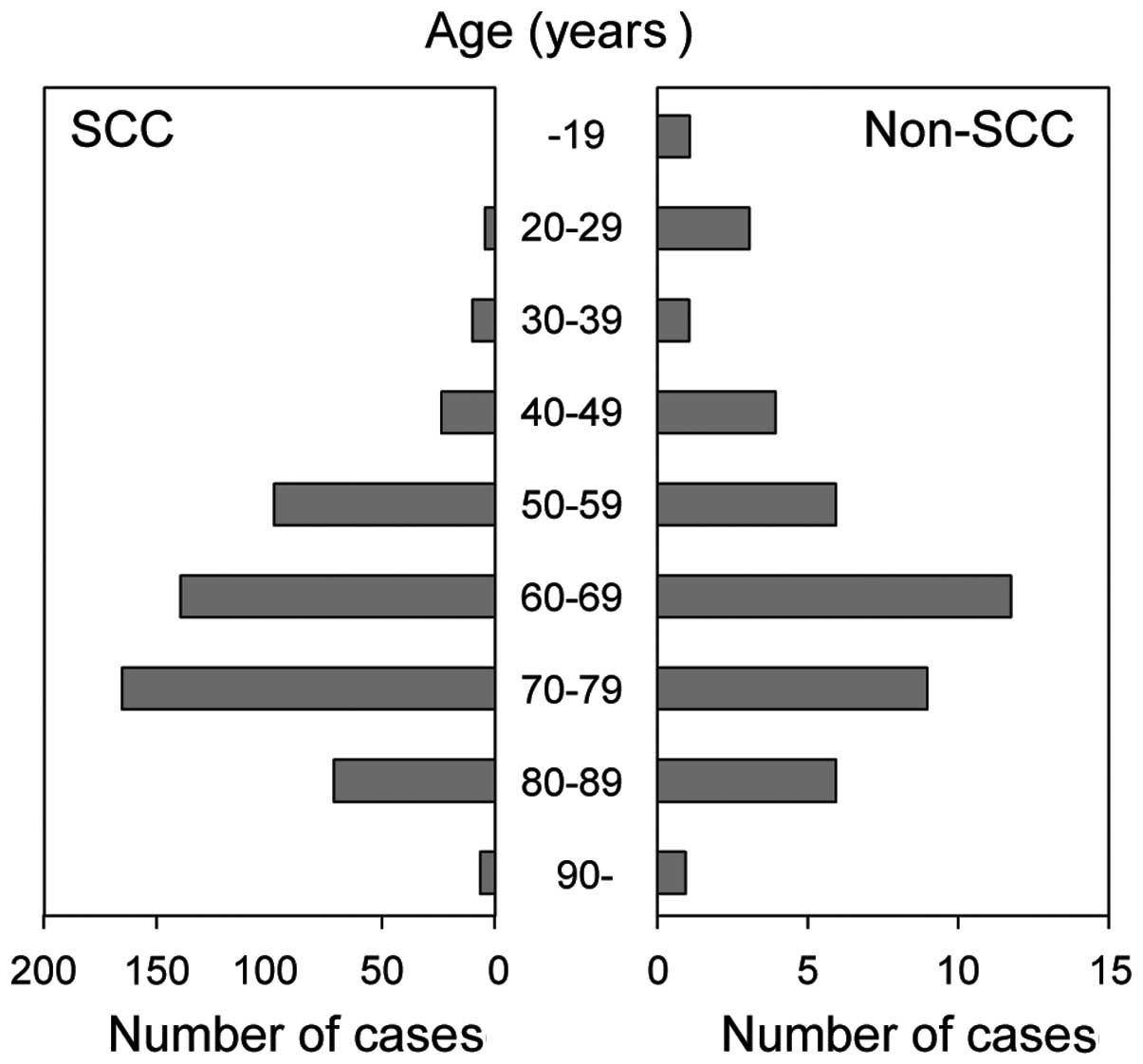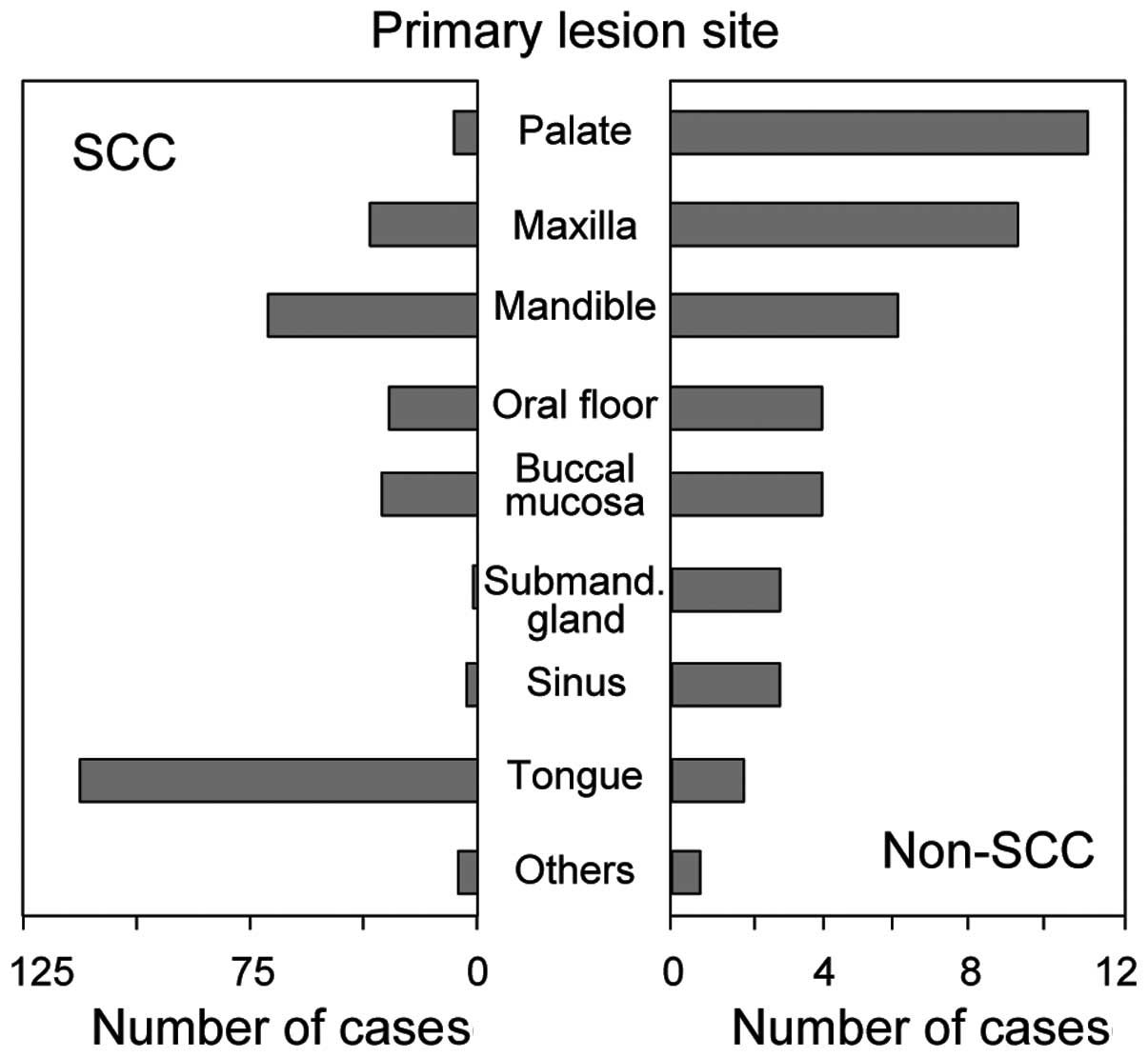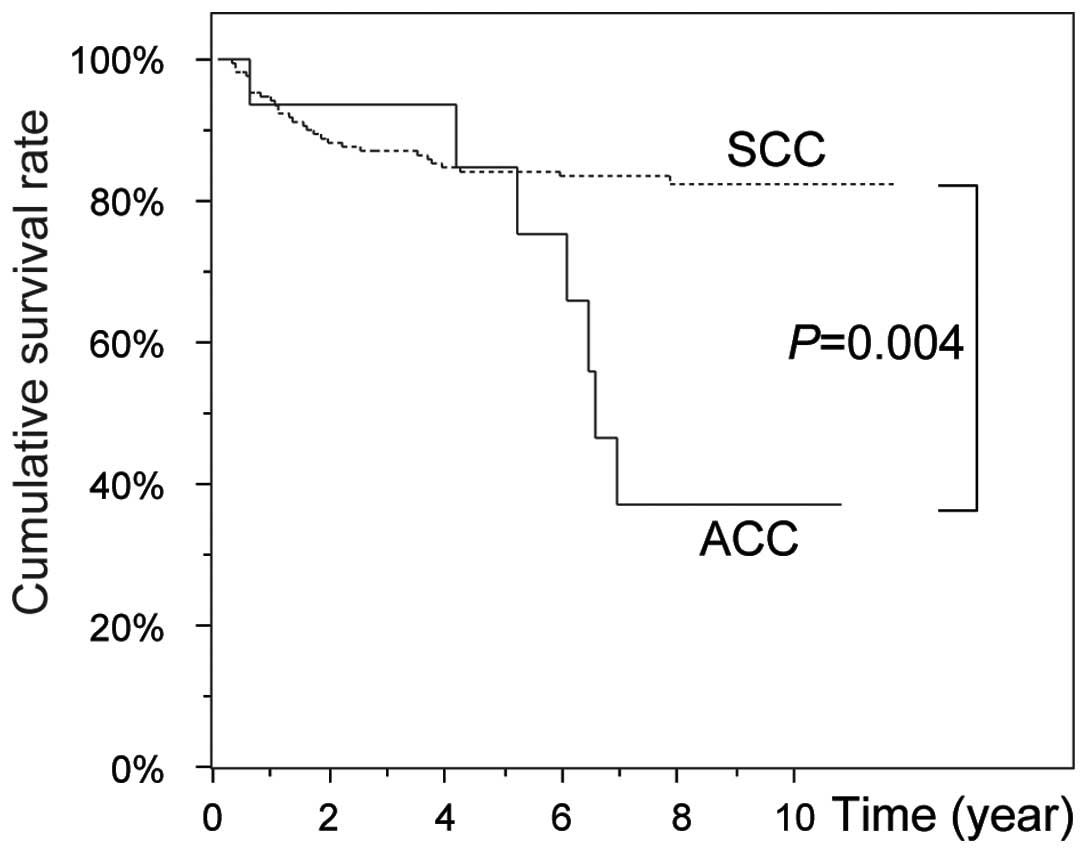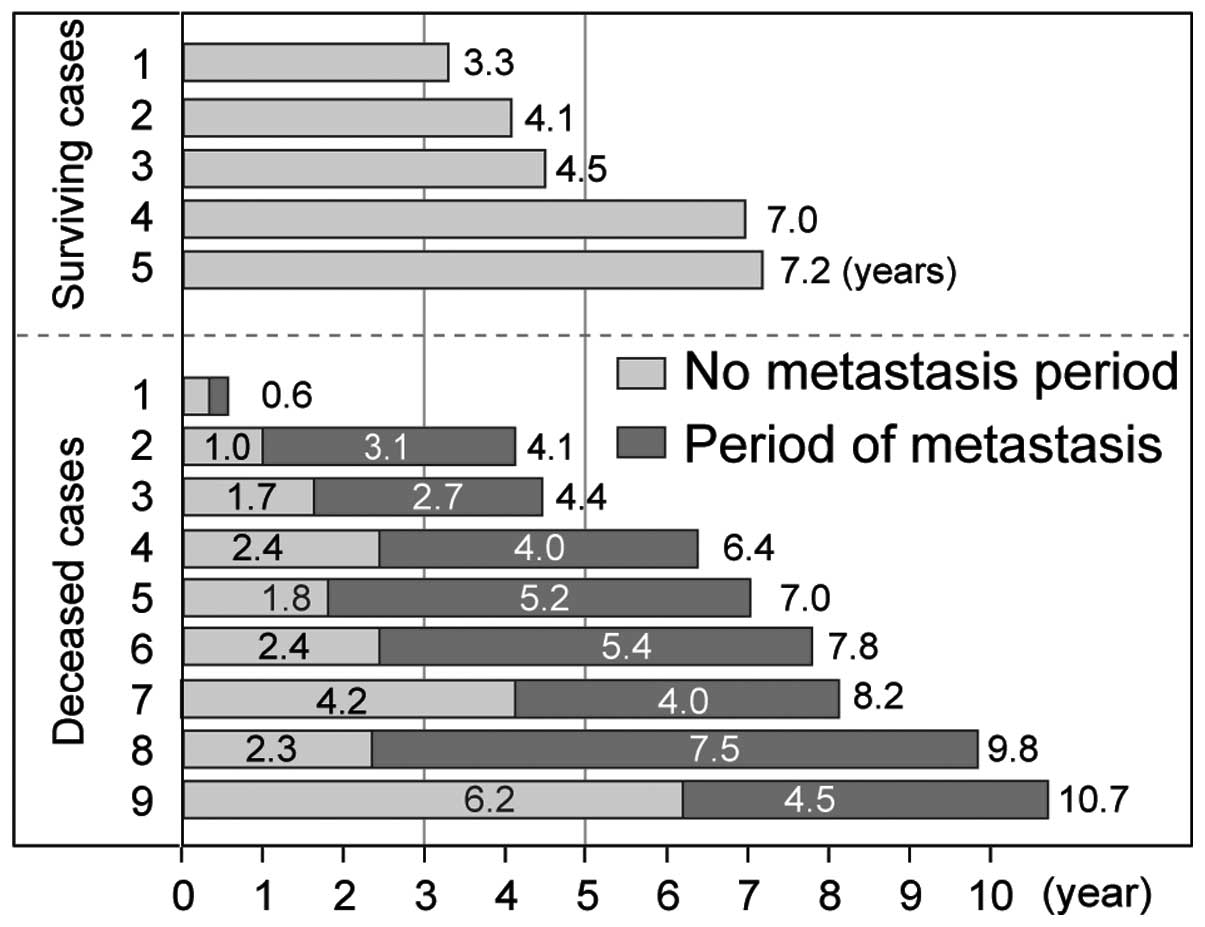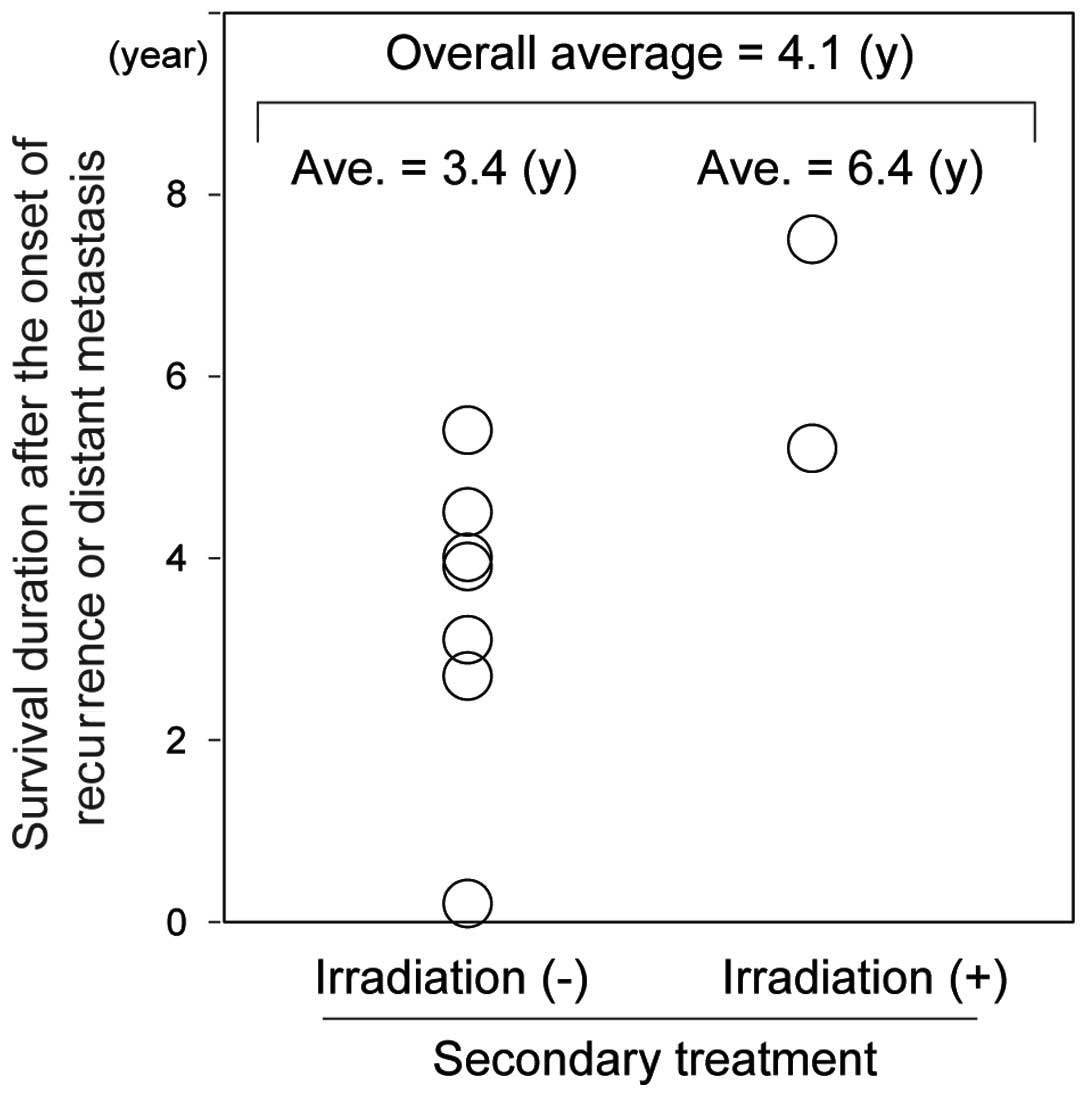Controlling distant metastasis and surgical treatment are crucial for improving clinical outcome in uncommon head and neck malignancies, such as non‑squamous cell carcinoma
- Authors:
- Published online on: May 8, 2014 https://doi.org/10.3892/mco.2014.291
- Pages: 609-617
Abstract
Introduction
Squamous cell carcinoma (SCC) is the most frequent malignant tumour of the head and neck region (1,2). Funk et al (3) reported that SCC accounts for 86.3% of head and neck malignancies. Uncommon malignancies, such as malignant lymphoma (4), adenoid cystic carcinoma (ACC) (5,6), adenocarcinoma (7) and mucoepidermoid carcinoma (8,9) are also found in the head and neck region; however, these tumours account for <5% of the total cases (2).
The rarity of these non-SCCs has prevented the implementation of evidence-based clinical improvements in their treatment. The number of malignant tumours has been hypothesized to increase in conjunction with the progression of medical science (10). Therefore, it is essential to expand our understanding of non-SCCs to improve their prognosis.
The aim of the present study was to investigate the clinical characteristics of non-SCCs in the head and neck region in order to improve clinical outcomes.
Materials and methods
Cases
Primary cases of malignant tumours in the head and neck region treated at the Division of Dentistry and Oral-Maxillofacial Surgery, Chiba University Hospital, between January, 1995 and December, 2010, were retrospectively investigated. All the cases were biopsied for diagnosis by pathologists and classified according to the World Health Organization guidelines (1). The cases were divided into two groups: SCCs and non-SCCs. Clinicopathological characteristics, including age, gender, primary lesion site, pathological diagnosis, TNM classification, treatment, distant metastasis and outcome were retrospectively analyzed using patient medical records to determine the clinical characteristics of non-SCCs.
Statistical analysis
The statistical analyses for distant metastasis in cases of ACC or clinical outcome associated with surgery were performed using the Fisher’s exact test. The overall survival rate was assessed using the Kaplan-Meier analysis and the difference was analyzed using the log-rank test. P<0.05 was considered to indicate a statistically significant difference.
Results
Patient characteristics
A total of 463 patients were included in this study, of whom 266 were men and 197 were women. The average age of the men was 61.6 years (range, 13–85 years) and that of the women 62.1 years (range, 29–94 years). In total, 43 cases (9.3%) were confirmed as non-SCC (Fig. 1A). Of the non-SCC cases, 20 (46.5%) were male (Fig. 1B) and the overall average age at the first visit was 61.8 years (range, 13–92 years). Of the 420 SCC cases, 246 (58.6%) were male (Fig. 1C) and the average age was 66.2 years (range, 21–94 years). The age distribution analysis revealed that a higher number of SCC patients were in the age range of 50–80 years. However, the non-SCC group included younger patients (aged <30 years) as well as older patients (Fig. 2). These data indicate that the non-SCC group included more women compared to the SCC group and that there is a wider age distribution trend in the non-SCC compared to the SCC group.
Among the SCC cases, the tongue was the most frequent primary site, followed by the mandible. However, non-SCCs occurred most frequently in the palate and maxilla (Fig. 3).
Pathological classification
The pathological classification revealed that ACC (14 cases) and haematolymphoid tumours (16 cases) were the most frequently encountered malignancies (Table I). Less frequent neoplasms included mucoepidermoid carcinoma (2 cases), basal cell adenocarcinoma (1 case), adenocarcinoma (1 case), malignant ameloblastoma (1 case), small-cell carcinoma (1 case), mucosal malignant melanoma (4 cases), rhabdomyosarcoma (2 cases) and synovial sarcoma (1 case). Patients with haematolymphoid tumours were referred to the Division of Internal Medicine for treatment. Therefore, ACC was the most frequently encountered non-SCC malignancy treated at our Department.
Treatment and outcomes
Surgery was mainly selected as the primary treatment, except for malignant lymphoma, with chemotherapy or radiotherapy administered as necessary. Conversely, malignant lymphoma was mainly treated with chemotherapy and/or radiotherapy (Table II). In cases with local recurrence or distant metastasis, additional surgery, chemotherapy and/or radiotherapy were administered.
The correlation between surgical treatment and outcome was analyzed in non-SCC cases, except for malignant lymphoma. Four patients did not undergo surgery and they all succumbed to the disease within 5 years (Table III). Conversely, 14 of the 19 patients (74%) who underwent surgery survived for >5 years. The 5-year survival rate was significantly higher among patients who underwent surgery compared to those who did not (P=0.014) (Table IV).
Table IIIComparison of 5-year survival rate between non-squamous cell carcinomas patients treated with and without surgery. |
Table IVComparison of outcome between primary treatment with and without surgery in non-squamous cell carcinomas, excluding malignant lymphoma. |
The 5-year survival rates were ≤50% for patients with adenocarcinoma, small-cell carcinoma, mucosal malignant melanoma, rhabdomyosarcoma and synovial sarcoma (Table I).
Salivary gland carcinomas
One ACC patient refused treatment. The remaining 13 ACC patients underwent surgery and additionally received radiotherapy or chemotherapy, as required. Among the 5 surviving ACC patients, 2 have survived for >5 years, while 6 of the 9 deceased ACC patients survived for >5 years after treatment. Thus, 8 of the 11 cases (73%) remained alive at the 5-year observation time point (Table I). Subsequently, the survival rate decreased significantly, resulting in a 10-year cumulative survival rate of 38% (Fig. 4). The cumulative survival rates at the 5-year observation time point between ACC and SCC patients were similar. However, the subsequent decrease in the ACC was more noticeable compared to the decrease in the SCC survival rate (P=0.004; Fig. 4).
Distant metastasis was not observed in any of the surviving patients. Distant metastases were observed in 9 of the 14 ACC cases, 6 of which occurred within 3 years following primary treatment (Fig. 5). Lung metastasis occurred in all patients with metastasis (Table V). The overall average survival duration following local recurrence or distant metastasis was 4.1 years and the survival duration was 3.4 and 6.4 years when treated with and without radiotherapy, respectively (Fig. 6). Distant metastasis was observed in 22 of the 420 SCC patients; thus, ACC exhibited a significantly higher incidence of distant metastasis compared to SCC (P<0.001) (Table VI). The ACC patient information is summarized in Table VII to clarify the association between clinicopathological factors and distant metastasis. The data demonstrated that the distant metastasis rate was significantly higher in T3+T4 when compared to that in T1+T2 cases (P=0.021). In addition, distant metastasis occurred in all the patients who experienced regional lymph node metastasis. Distant metastasis was frequently observed in the sinus (100%), submandibular gland (100%) and oral floor (75%), but was comparably rare in the palate (33%) (Table VII). There was no significant association between distant metastasis and histological type.
Table VIComparison of distant metastasis incidence between adenoid cystic carcinoma and squamous cell carcinoma. |
Table VIICorrelation of clinicopathological factors with distant metastasis in adenoid cystic carcinoma. |
In addition, there were 2 cases of mucoepidermoid carcinoma, 1 advanced case of adenocarcinoma and 1 case of basal cell adenocarcinoma. The 2 cases with mucoepidermoid carcinoma were treated with surgery, including neck dissection, and the patients have remained alive for 7 and 11 years, respectively, with no evidence of recurrence or metastasis (Table VIII). The advanced adenocarcinoma case was staged as T3N2bM0 (Table VI). The patient underwent surgical tumour resection and neck dissection. Additional treatments, such as adjuvant chemotherapy and radiotherapy were planned; however, neither was administered due to the patient’s poor overall condition. After 8 months, multiple lymph node metastases were detected in the neck. The patient did not consent to further treatment and eventually succumbed to the disease 17 months after her first visit.
Haematolymphoid tumours
Three patients underwent surgery, were diagnosed with malignant lymphoma and were referred to the Internal Medicine Department. For the other malignant lymphoma cases, biopsy or image analyses were used for diagnosis and the patients were directly referred to Internal Medicine. All the malignant lymphoma cases were non-Hodgkin lymphomas, with 13 cases of B-cell neoplasms and 3 cases of natural killer or T-cell (NK/T) neoplasms (Table IX). Chemotherapy or radiotherapy was the main therapeutic option for patients with malignant lymphoma (Tables II and IX). At the 5-year observation time point, 5 of the 11 malignant lymphoma cases (45%) had survived (Table I). The median observation period for surviving patients and the survival period for deceased patients were 6.0 and 3.6 years, respectively. Of the NK/T-cell lymphoma patients, 2 succumbed to the disease and 1 has remained alive for 5 years without recurrence. The surviving NK/T-cell lymphoma patient is a 28-year-old woman who was treated with radiotherapy (50 Gy) and 3 courses of dexamethasone, etoposide, ifosfamide and carboplatin (DeVIC).
Other malignancies
A case of small-cell carcinoma (neuroendocrine type) was treated by surgery (tumour resection and neck dissection) and concurrent chemoradiotherapy, which comprised 5 courses of cisplatin + etoposide (PE) and 1 course of cisplatin + irinotecan (PI), with 66 Gy of radiotherapy (Table VIII). This malignancy is common in the lung but extremely rare in the head and neck region (11,12). Since PE and PI are considered to be the standard treatment for SCC of the lung, they were selected for this case. However, the patient succumbed to the disease 18 months after his first visit.
In total, 4 cases of malignant melanoma were treated (Table X). All the patients succumbed to the disease at 2, 3, 8 and 10 years after diagnosis. The 2 patients who survived the longest had undergone tumour resection with regional neck dissection, combined with chemotherapy or concurrent chemoradiotherapy. Surgical treatment was suggested to the remaining 2 patients, who experienced a shorter survival. However, both patients refused surgery and opted for chemotherapy or concurrent chemoradiotherapy.
A total of 2 rhabdomyosarcoma patients and 1 synovial sarcoma patient visited our Department (Table XI). The outcomes for the rhabdomyosarcoma cases were poor. The first rhabdomyosarcoma patient was a 13-year-old boy. The CT scan revealed multiple metastases in the lungs, suggesting that surgical treatment was not feasible. Thus, the patient was immediately transferred to the Pediatrics Department for chemotherapy. The patient finally succumbed to respiratory dysfunction 9 months after his first visit. The second rhabdomyosarcoma patient was a 61-year-old woman who was treated with surgery and chemoradiotherapy. The treatment achieved effective control of the local lesion; however, distant lung metastasis occurred and compromised the patient’s general condition. It should be noted that both rhabdomyosarcoma patients succumbed to their disease within 2 years after their first visits.
The synovial sarcoma patient was a 66-year-old man treated with surgery. Although there was no evidence of recurrence, the patient died of hepatocellular carcinoma 2 years after surgery.
Discussion
The incidence of SCC is higher compared to that of non-SCC (2), a fact also confirmed by our study (90.7 vs. 9.3%, respectively). In addition, our data revealed that the clinical outcomes of certain non-SCC cases were not satisfactory when compared to those of SCC cases, indicating that, although non-SCCs are minor diseases from the perspective of epidemiology, these cases should be managed carefully. A possible explanation as to why treatment of head and neck non-SCCs is difficult may lie with their low frequency. Therefore, the accumulated clinical observations provided in the present study may be of great value. All clinicians should disclose information on the head and neck non-SCC cases they encounter in order to share this limited information and improve clinical outcomes.
The cumulative survival rates were found to be significantly worse in ACC compared to those in SCC patients (P=0.004; Fig. 4). The unsatisfactory outcome of ACC may be due to the early and high incidence of distant metastasis. In the present study, 6 metastases occurred within 3 years after primary treatment and all the patients who experienced distant metastasis eventually succumbed to the disease. Conversely, distant metastasis was not observed in any of the surviving cases. The distant metastasis rate of ACC was significantly higher compared to that of SCC (Table VI). Our data revealed that tumour size is the most significant risk factor for distant metastasis. Therefore, timely diagnosis and treatment are essential in ACC cases. Although no definitive clinical approach for preventing distant metastasis has been established, it was previously reported that surgery with postoperative radiotherapy significantly improved the outcomes (13). Additionally, Lin et al (14) reported that postoperative radiotherapy reduced the recurrence rate in patients with a negative resection margin. In the present study, the effect of postoperative irradiation on recurrence in margin-negative cases was not confirmed. The overall average survival duration following local recurrence or distant metastasis was 4.1 years, indicating that metastasized tumours progress slowly or secondary treatment may suppress tumour development to a certain extent. It is also crucial to maintain the quality of life following recurrence or distant metastasis in ACC patients. Of the cases with metastasis, 2 out of 9 underwent radiotherapy for distant lesions and the average survival duration was 6.4 years (Fig. 6). Therefore, radiotherapy for metastatic disease should be considered as the primary therapeutic option.
A number of cases with haematolymphoid tumours were also observed. All the cases were non-Hodgkin lymphomas, comprising 13 B-cell neoplasms and 3 NK/T-cell neoplasms. NK/T-cell lymphoma is generally aggressive and is associated with a poor outcome (15,16). Of the patients with 3 NK/T-cell lymphoma, 2 succumbed to the disease and 1 has survived for 5 years without any evidence of recurrence. Cyclophosphamide, doxorubicin, vincristine and prednisone therapy followed by radiotherapy is currently the established standard treatment for localized non-Hodgkin lymphoma (17). However, as the outcome of localized NK/T-cell lymphoma (nasal type) treated with this therapy is not satisfactory, concurrent chemoradiotherapy as a therapeutic option has been investigated in Japan. A phase I/II trial of concurrent chemoradiotherapy (DeVIC and 50 Gy irradiation) for localized nasal NK/T-cell lymphoma was conducted and the authors concluded that this regimen should be recommended as a first-line treatment for this type of malignancy (18). The surviving NK/T-cell lymphoma patient in our study was a 28-year-old woman who initially presented with a stage I localized lesion in her upper gingiva. The patient was immediately referred to our Department for prompt treatment and received radiotherapy (50 Gy) and 3 courses of DeVIC. These findings indicate that initiating treatment at an early stage is crucial and that concurrent chemoradiotherapy should be recommended hereafter for NK/T-cell lymphomas.
In the present study, there were 4 cases of mucosal malignant melanoma. Two of the patients (50%) exhibited long-term survival; however, all the patients eventually succumbed to their disease. Malignant melanoma of the head and neck is difficult to cure. Of the deceased patients, 2 died within 3 years after treatment, whereas the remaining 2 patients survived for a significantly longer period. A 74-year-old male patient survived for 10 years, despite developing distant metastases in the lung and brain. In addition, a 67-year-old female patient survived disease-free for ~8 years until distant metastasis to her lung and bronchus occurred. Both patients underwent surgery, including neck dissection, indicating that resection of the primary lesion and regional lymph nodes may prolong survival. However, distant metastasis, mainly to the lungs, hampers the management of head and neck malignant melanoma.
Rhabdomyosarcoma is a malignant soft tissue tumour of skeletal muscle origin that is most commonly encountered in the head and neck region (19). Rhabdomyosarcoma frequently occurs in childhood, particularly in individuals aged <15 years. Indeed, in the present study, of the 2 rhabomyosarcoma patients, 1 was a 13-year-old boy. Both rhabdomyosarcoma patients developed distant lung metastasis and succumbed to their disease within 2 years of their first visits. In a review of sarcomas of the oral and maxillofacial region, Yamaguchi et al (20) reported that 3 of 5 rhabdomyosarcoma cases died within 3 years after treatment and that distant metastasis occurred in the deceased but not in the surviving and disease-free patients. These observations strongly indicate that distant metastasis is a major complication contributing to the poor outcome in patients with rhabdomyosarcoma and malignant melanoma.
Overall, the data of the present study indicate that non-SCC patients frequently develop distant metastasis to the lung and that the survival rate was significantly higher in the non-SCC patients who underwent surgery compared to those who did not. Furthermore, we hypothesized that the poor outcomes may be due to the limited amount of clinical information available regarding these rare malignancies. However, the present study was limited by the fact that it was a single-center study with a limited number of non-SCC cases. Therefore, the continued accumulation of information from various clinical trials and other studies is required for improving the clinical outcomes of non-SCCs patients.
In conclusion, our data indicated that non-SCC malignant tumours of the head and neck are relatively rare. However, non-SCC malignant tumours are a clinically significant entity, as their management is generally difficult. Timely treatment and control of distant metastasis are essential and surgical treatment should be prioritized in non-SCC cases in order to improve the outcomes in such patients.
Abbreviations:
|
SCC |
squamous cell carcinoma |
References
|
Slootweg PJ and Eveson JW: Tumours of the oral cavity and oropharynx. World Health Organization Classification of Tumours (Pathology and Genetics of Head and Neck Tumours). Barnes L, Eveson JW, Reichart P and Sidransky D: IARC Press; Lyon: pp. 163–165. 2005 | |
|
Krolls SO and Hoffman S: Squamous cell carcinoma of the oral soft tissues: a statistical analysis of 14,253 cases by age, sex, and race of patients. J Am Dent Assoc. 92:571–574. 1976. View Article : Google Scholar : PubMed/NCBI | |
|
Funk GF, Karnell LH, Robinson RA, Zhen WK, Trask DK and Hoffman HT: Presentation, treatment, and outcome of oral cavity cancer: a National Cancer Data Base report. Head Neck. 24:165–180. 2002. View Article : Google Scholar : PubMed/NCBI | |
|
Kemp S, Gallagher G, Kabani S, Noonan V and O’Hara C: Oral non-Hodgkin’s lymphoma: review of the literature and World Health Organization classification with reference to 40 cases. Oral Surg Oral Med Oral Pathol Oral Radiol Endod. 105:194–201. 2008. | |
|
Al-Sukhun J, Lindqvist C, Hietanen J, Leivo I and Penttilä H: Central adenoid cystic carcinoma of the mandible: case report and literature review of 16 cases. Oral Surg Oral Med Oral Pathol Oral Radiol Endod. 101:304–308. 2006. View Article : Google Scholar : PubMed/NCBI | |
|
Khan AJ, DiGiovanna MP, Ross DA, et al: Adenoid cystic carcinoma: a retrospective clinical review. Int J Cancer. 96:149–158. 2001. View Article : Google Scholar : PubMed/NCBI | |
|
Parashar P, Baron E, Papadimitriou JC, Ord RA and Nikitakis NG: Basal cell adenocarcinoma of the oral minor salivary glands: review of the literature and presentation of two cases. Oral Surg Oral Med Oral Pathol Oral Radiol Endod. 103:77–84. 2007. View Article : Google Scholar : PubMed/NCBI | |
|
do Prado RF, Lima CF, Pontes HA, Almeida JD, Cabral LA and Carvalho YR: Calcifications in a clear cell mucoepidermoid carcinoma: a case report with histological and immunohistochemical findings. Oral Surg Oral Med Oral Pathol Oral Radiol Endod. 104:e40–e44. 2007.PubMed/NCBI | |
|
Corcione L, Giordano G, Gnetti L, Multinu A and Ferrari S: Oncocytic mucoepidermoid carcinoma of a submandibular gland: a case report and review of the literature. Int J Oral Maxillofac Surg. 36:560–563. 2007. View Article : Google Scholar : PubMed/NCBI | |
|
Sciubba JJ: Oral cancer. The importance of early diagnosis and treatment. Am J Clin Dermatol. 2:239–251. 2001. | |
|
Terada T: Small cell carcinoma of the oral cavity (cheek mucosa): a case report with an immunohistochemical and molecular genetic analysis. Int J Clin Exp Pathol. 6:780–787. 2013.PubMed/NCBI | |
|
Shenoy N, Sholapurkar AA, Pai KM and Pal K: Small cell carcinoma of the oral cavity: report of a rare case. J Calif Dent Assoc. 37:399–401. 2009.PubMed/NCBI | |
|
Shen C, Xu T, Huang C, Hu C and He S: Treatment outcomes and prognostic features in adenoid cystic carcinoma originated from the head and neck. Oral Oncol. 48:445–449. 2012. View Article : Google Scholar : PubMed/NCBI | |
|
Lin YC, Chen KC, Lin CH, Kuo KT, Ko JY and Hong RL: Clinicopathological features of salivary and non-salivary adenoid cystic carcinomas. Int J Oral Maxillofac Surg. 41:354–360. 2012. View Article : Google Scholar : PubMed/NCBI | |
|
Schmitt C, Sako N, Bagot M, Huang Y, Gaulard P and Bensussan A: Extranodal NK/T-cell lymphoma: toward the identification of clinical molecular targets. J Biomed Biotechnol. 2011:7908712011. View Article : Google Scholar : PubMed/NCBI | |
|
Coha B, Vucinic I, Mahovne I and Vukovic-Arar Z: Extranodal lymphomas of head and neck with emphasis on NK/T-cell lymphoma, nasal type. J Craniomaxillofac Surg. 42:149–152. 2014. View Article : Google Scholar : PubMed/NCBI | |
|
Miller TP, Dahlberg S, Cassady JR, et al: Chemotherapy alone compared with chemotherapy plus radiotherapy for localized intermediate- and high-grade non-Hodgkin’s lymphoma. N Engl J Med. 339:21–26. 1998.PubMed/NCBI | |
|
Yamaguchi M, Tobinai K, Oguchi M, et al: Concurrent chemoradiotherapy for localized nasal natural killer/T-cell lymphoma: an updated analysis of the Japan clinical oncology group study JCOG0211. J Clin Oncol. 30:4044–4046. 2012. View Article : Google Scholar : PubMed/NCBI | |
|
Miloglu O, Altas SS, Buyukkurt MC, Erdemci B and Altun O: Rhabdomyosarcoma of the oral cavity: a case report. Eur J Dent. 5:340–343. 2011.PubMed/NCBI | |
|
Yamaguchi S, Nagasawa H, Suzuki T, et al: Sarcomas of the oral and maxillofacial region: a review of 32 cases in 25 years. Clin Oral Investig. 8:52–55. 2004.PubMed/NCBI |




